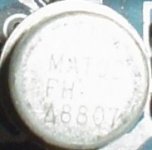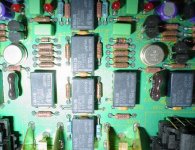chascode said:My dad used to machine the titanium connecting rods for off-shore power boat racing big-block Chevy engines, and those rods and the metal head gaskets were cryo treated for longer life at high temperature, high rpm operation.
I guess you haven't learned the lesson. The fact that somebody markets this stuff, and somebody else buys it doesn't give it any more basis in reality. Look at those Q-Ray ionizing bracelet things.
fizzard said:I guess you haven't learned the lesson. The fact that somebody markets this stuff, and somebody else buys it doesn't give it any more basis in reality. Look at those Q-Ray ionizing bracelet things.
Why do you insist on parading your ignorance? A quick Google search will confirm that cryogenic treatments have been proven to strengthen many materials.
Cryogenic: I will be tackling that soon. This bit should exceed that one by a good unholy margin.
However, I definitely am looking for a good circuit or two to market it with. Any of you guys game? I'm very serious.
My latest creation, which is one of the very few I've actually 'let loose' is now starting to 'hit the streets' as they say, in the audio world. It is at the most extreme of the highest end, in it's category, and the most technically advanced. Brutally simple as well, it's almost a bit too sublime. I have many more tricks. I'm not talking ego here, I'm simply attempting to say that this might make you take me seriously, when I say I'm looking for a good circuit or two.
Some of you are aware of the thing that is being marketed, and I'd appreciate it that it not get buzzed about on the boards here - for a bit longer. So please don't bring it up. Let them discover it on their own.
However, I definitely am looking for a good circuit or two to market it with. Any of you guys game? I'm very serious.
My latest creation, which is one of the very few I've actually 'let loose' is now starting to 'hit the streets' as they say, in the audio world. It is at the most extreme of the highest end, in it's category, and the most technically advanced. Brutally simple as well, it's almost a bit too sublime. I have many more tricks. I'm not talking ego here, I'm simply attempting to say that this might make you take me seriously, when I say I'm looking for a good circuit or two.
Some of you are aware of the thing that is being marketed, and I'd appreciate it that it not get buzzed about on the boards here - for a bit longer. So please don't bring it up. Let them discover it on their own.
Fizzard, how much real world experience do you have? What do you know about cryoing? I have a US military pamphlet on cryoing that gives its history to WW1, when they cryoed submarine hatches to keep them from leaking. In WW2 all the equipment that made bullet casings was cryoed and the EFFECTS measured, as the tools did NOT wear out as fast.
This is but one example of someone thinking that nothing outside his immediate understanding is nonsense. We might just talk to some native islanders and get the same response, on even more basic things like: Does the Sun revolve around the Earth? etc, etc
This is but one example of someone thinking that nothing outside his immediate understanding is nonsense. We might just talk to some native islanders and get the same response, on even more basic things like: Does the Sun revolve around the Earth? etc, etc
Charles Hansen said:
Why do you insist on parading your ignorance? A quick Google search will confirm that cryogenic treatments have been proven to strengthen many materials.
Again, just because it's marketed, and just because people buy it doesn't make it true. Just because there's an industry association doesn't make it true either. The tobacco industry has an association that likes to claim that their product doesn't cause cancer.
In the petroleum and gas industry there are endless highly critical applications. 60,000 HP reciprocating compressor intense enough for you? When that compressor is compressing hydrogen, the metallurgy better be good. The QC records for the crankshaft alone fill about three feet of shelf space. Of all the advanced alloys, and proprietary treatment processes, developed by the deep pockets of the oil industry (thanks to all the Hummers out there), not a single part is "cryo" treated... anywhere... period. Hundreds of tons of hydrogen and vapourized hydrocarbons at hundreds of atmospheres of pressure. And yes, in my spare time I have thoroughly perused the documentation.
And Mr. Curl, we do have abbrasive problems as well, to the tune of a few thousands kg of steal lost to abbrasion a day. And we also have a plant that makes liquid nitrogen on demand, a few thousands gallons a day, if you need it. So cost and practicality aren't issues at all. Maybe you could tell me why we don't? Because I obviously don't know.
Again, what do you have against the US military? Do you think they are lying too? Being cynical without good cause makes a poor showing, at least to me.
There's a few guys around here that I wish would stop using the forum as a launch pad for their stratospheric ego's.
Bonsai said:There's a few guys around here that I wish would stop using the forum as a launch pad for their stratospheric ego's.
Interesting post for a guy in marketing. 🙂
The resistors do have some form of conformal coating. The metals and substrate are pretty stable materials and not highly reactive. I didn't notice a significant price difference between them and S102 epoxy encapsulated resistors so why not? My stuff doesn't need to meet shake and bake requirements and won't be used in high humidity environments (Shipboard) so I'll go with them.janneman said:On those Vishay naked resistors, are these really 'naked'? I mean, is there no encapsulation over the resistive element? To protect them from air-borne oxidants and other agressive pollutants?
Jan Didden
I also use Caddock resistors in some applications. There are resistance ranges where I'm told one is superior to the other, but I haven't the patience to verify the claims.
I do hear significant improvements with these resistors. I am not ready to attribute the performance to any one aspect and it may be some aspect I'm not aware of that contributes to the sound.
Here is one to think about- in superconductivity it seems surface flaws ("cracks") are important for the superconductivity to happen. Perfectly amorphous materials do not work as well. A physical reality that seems very counter-intuitive. The Memistor discovery also challenges the basic understanding of electronic behavior. Perhaps I don't understand "electron flow" as well as I thought.
GRollins said:John's Blowtorch enclosure would work well
I wish i had built amps like that, innert gas injected and sealed edges.
Earlier this week i opened up one of my earlier preamp hysterics, to discover that the printing of the MATs on the board has become unreadable due to corrosion.
Not everyone may be living at 500 yards from the sea shore, with romantic refinery flare pipes litting the evening sky in a 180 degree setting at 5 miles distance. (from my next publication : Bride gimme head revisited)
Sealing part of a board with an alloy pan wouldn't be such a great adventure to protect expensive hardware.
(in case Mr Wurcer failed to see the catch: PMI-> Port Meirion. Beautiful place, as is most of Wales )
Attachments
1audio said:
The resistors do have some form of conformal coating. The metals and substrate are pretty stable materials and not highly reactive. I didn't notice a significant price difference between them and S102 epoxy encapsulated resistors so why not? My stuff doesn't need to meet shake and bake requirements and won't be used in high humidity environments (Shipboard) so I'll go with them.
[snip]
Hi Demian,
Maybe I'm a bit dense, but in reading the Vishay blurb I got the impression (and I think that is what they were suggesting) that these resistors are NOT coated, thus naked. Also that somehow that would make them better devices. Now are they coated or not? If so, fine, but what's with the naked then? I hope that a respectable company like Vishay is not stooping to suggesting half-truths in the interest of increasing sales to the gullible? I sure hope not.
Jan Didden
john curl said:Again, what do you have against the US military? Do you think they are lying too? Being cynical without good cause makes a poor showing, at least to me.
John,
I don't think anybody denies that cryo-ing (sp?) does change material properties. That's not the issue, please don't pretend it is.
The issue, as I distill it from these posts, is why it should have an audible effect, and a positive one at that. Do we have any info on that, not anecdotal but verifiable and repeatable?
Jan Didden
OT
@ janneman,
i indeed got the impression that fizzard was denying any positive result after cryogenic treatment of any material.
That is interesting because afaik at least the cryogenic treatment of steel has documented benefits and got a theoretical basis (and proove) to explain what happens during the treatment process. (keywords are transformation from austenit to martensit).
Of course, proove of audibility is a totally different topic. 🙂
But as usual nobody is forced to believe something, but is free to try and listen for himself.
Jakob2
@ janneman,
i indeed got the impression that fizzard was denying any positive result after cryogenic treatment of any material.
That is interesting because afaik at least the cryogenic treatment of steel has documented benefits and got a theoretical basis (and proove) to explain what happens during the treatment process. (keywords are transformation from austenit to martensit).
Of course, proove of audibility is a totally different topic. 🙂
But as usual nobody is forced to believe something, but is free to try and listen for himself.
Jakob2
Hi, Jacob2,
What is the mechanism that this can affect sound?
I understand austenite, martensite, quenching, tempering etc. It relates to hardness, brittleness.(keywords are transformation from austenit to martensit).
What is the mechanism that this can affect sound?
are there equivalents for copper, lead, zinc, tin, silver and combinations thereoff?lumanauw said:Hi, Jacob2,
I understand austenite, martensite, quenching, tempering etc. It relates to hardness, brittleness.
What is the mechanism that this can affect sound?
It seems there was nothing in this world that would not have influence on highend gear sound. There are no limits! 😀
Pavel,
why the scepticism ?
A long time ago i spent plenty of days eyeballin different silicate crystal development in smelly rocks at the Amsterdammed-U faculty of geology.
You're professionally involved in the business of electrons travelling through doped silicon structures.
If recrystalising works for high tensile steels, why not for your favorite toys ?
why the scepticism ?
A long time ago i spent plenty of days eyeballin different silicate crystal development in smelly rocks at the Amsterdammed-U faculty of geology.
You're professionally involved in the business of electrons travelling through doped silicon structures.
If recrystalising works for high tensile steels, why not for your favorite toys ?
PMA said:It seems there was nothing in this world that would not have influence on highend gear sound. There are no limits! 😀
And finally it will sound much better than the original performance. 😀
- Status
- Not open for further replies.
- Home
- Amplifiers
- Solid State
- John Curl's Blowtorch preamplifier

